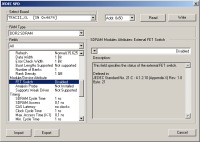Facts JEDEC SPD
History
In modern PCs a lot of different types of memory modules can be used. The PC’s chipset has to know a lot of parameters about the RAM ICs used on these memory modules (e.g. cycle time, access time, RAS/CAS delay, hold time).
At the beginning the user had to enter these parameters more or less manually in the PC BIOS. For most users without knowledge about RAM technology this was a very difficult and fault-prone task.
SPD Standard
To make things easier the JEDEC organisation (http://www.jedec.org) developed the SPD (Serial Present Detect) standard. This standard introduced plug-and-play to memory modules.
All newer memory module types like SDRAM, DDR SDRAM, and DDR2 SDRAM are using SPD.
A memory module supporting the Serial Present Detect coding contains a small I2C EEPROM. The manufacturer stores all necessary parameters describing the used RAM ICs in this device. During start-up of the PC the BIOS reads the SPD EEPROMs of all memory modules via the SMBus and configures the chipset to match these parameters.
Tools
Tracii XL and Tracii XL 2.0 support the developers and manufacturers of PC memory modules by the following features:
- read and write SPD images via Tracii XL/Tracii XL 2.0
- import and export SPD images
- dialog for creating and interpreting SPD images
To use the JEDEC SPD support you want a Tracer option for your Tracii XL/Tracii XL 2.0.

